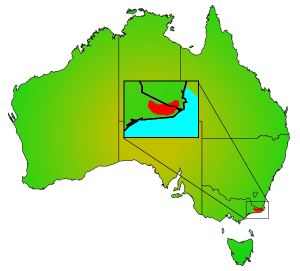East Gippsland spiny crayfish facts for kids
Quick facts for kids East Gippsland spiny crayfish |
|
|---|---|
| Conservation status | |
| Scientific classification | |
| Genus: |
Euastacus
|
| Species: |
bidawalus
|
The East Gippsland spiny crayfish (scientific name: Euastacus bidawalus) is a type of freshwater crayfish. It lives only in certain parts of Australia. You can find it in the East Gippsland area of Victoria and along the far south coast of New South Wales.
Contents
About This Crayfish
The East Gippsland spiny crayfish looks a lot like other crayfish in its family. It's especially similar to the Orbost Spiny Crayfish. These crayfish can grow up to about 4.8 centimeters (almost 2 inches) long, measured from their head to the start of their tail.
Their head, called a cephalon, usually has only a few small spines or rounded bumps. Smaller crayfish might have sharper spines. Their body, or thorax, has a line of five to eight medium-sized spines on each side. The spine on top is often bigger and sharper.
The crayfish's body is divided into segments. The first segment of its tail section doesn't have spines on the sides. Segments two through five usually have one main spine on each side, especially in larger crayfish. These spines get bigger and sharper as the crayfish grows. The tail fan, which helps it swim, doesn't have any spines.
E. bidawalus can be green-brown or red-brown on its back. Its sides are paler, turning cream and orange on its belly. The main claws have orange or brown parts with green or blue spots. The tips of the claws are blue-green.
Where It Lives
The East Gippsland spiny crayfish lives in areas that are 150 to 400 meters (about 490 to 1,300 feet) above sea level. It has been found in rivers that flow south and east. These rivers stretch from Lind National Park, which is west of Cann River, all the way to near Mount Imlay south of Eden.
Its Home Environment
This crayfish spends most of its life hidden away in long burrows. It only comes out at night. It likes to live in areas near the edges of streams and in swampy places. You can find it in dry forests, but also in cleared areas where some plants are still left along the streams.
Life and Babies
East Gippsland spiny crayfish start breeding around May or June. The female crayfish carries her eggs until about December or January. Their eggs are quite large, but females usually only lay a small number, typically between 20 to 40 eggs. Females are ready to have babies when they are about 4 centimeters (1.6 inches) long.
Protecting This Crayfish
The East Gippsland spiny crayfish is listed as an endangered species. This means its population is at risk. Even though it's endangered, it can be found quite often in the suitable areas where it lives, though these areas are sometimes spread out.
Why Humans Don't Eat It
These crayfish are not eaten by humans. They are too small to be used for food. They never grow big enough to reach the minimum legal size for catching crayfish in both Victoria and New South Wales, which is 9 centimeters (about 3.5 inches) long.



